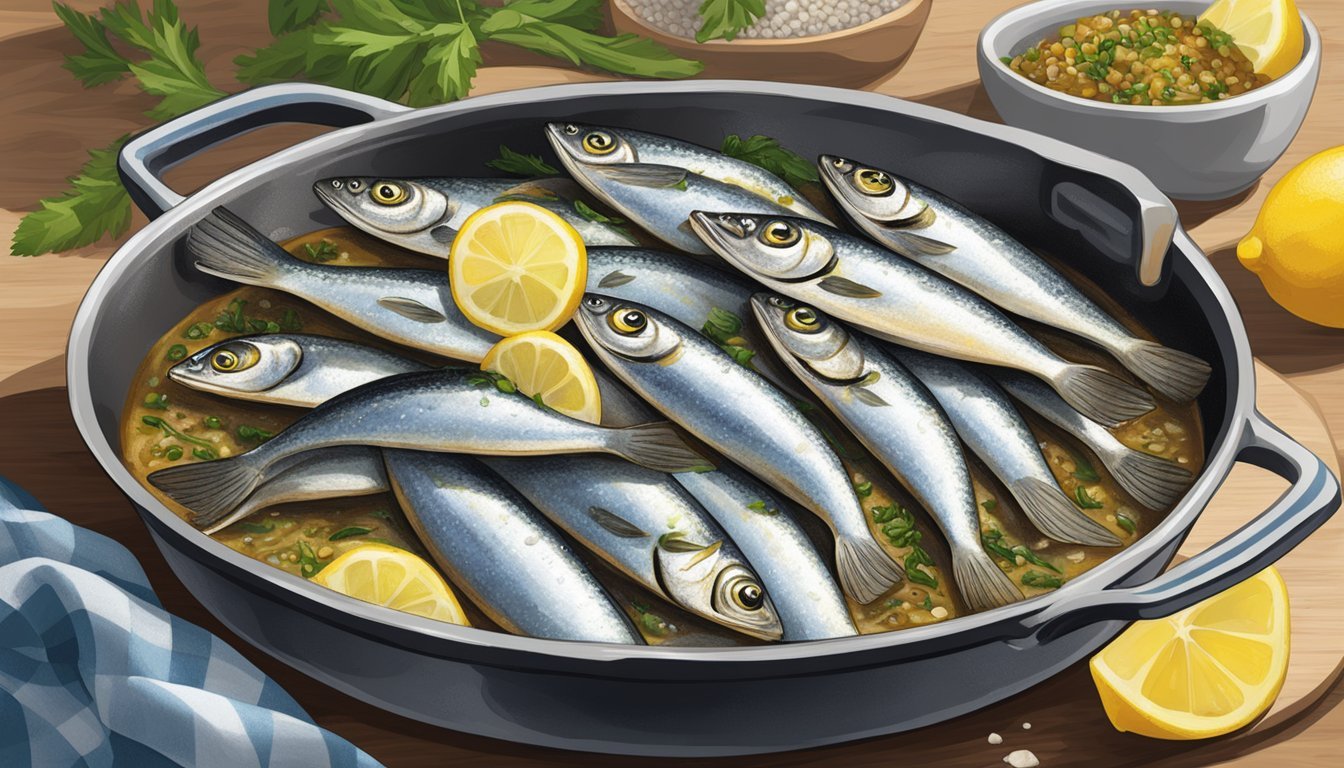How Do You Eat Xouba:
A Guide to Enjoying Small Sardines
Xoubas, commonly known as small sardines, are a culinary delight hailing from the region of Galicia, Spain, and are celebrated for their versatility in the kitchen. These tiny fish are often compared to sardines due to their similar appearance and taste; however, xoubas are notable for their tender texture and distinct flavor profile. Packed with nutrients, they are traditionally enjoyed fresh during their peak season, which runs from June to October, although they are also available preserved in cans outside of these months.
In Galician cuisine, xoubas can be prepared in a variety of ways that showcase their delicate flavor. One popular method is grilling them with coarse salt, which punctuates their richness without overpowering their natural taste. This process involves salting the fish for an hour or two, shaking off the excess, and then placing them on a hot griddle or pan, cooking them for 3 to 4 minutes on each side, depending on size. The importance of timing cannot be overstated; overcooking xoubas can dry them out and diminish their flavor.
Aside from grilling, xoubas are also incorporated into stews (What wine goes well with stews?) and pastas, imbuing these dishes with their savory essence. In stews, they are often complemented with ingredients such as onions, garlic, and tomatoes, creating a harmonious blend of flavors. Cooks who prefer a simple yet satisfying dish might turn to pasta, which pairs the oily fish with ingredients like garlic and herbs to create a hearty meal. Whether grilled, stewed, or tossed into pasta, xoubas offer a culinary adventure with each method revealing a new aspect of their character.
Nutritional Profile of Xouba
Xouba, small sardines, are nutrient-dense, offering a rich blend of vitamins, minerals, and fatty acids. They are particularly known for their high content of omega-3 fatty acids and their role in supporting overall health.
Key Nutrients Found in Xouba
Protein: Xouba is an excellent source of protein, which is crucial for muscle repair and growth.
Fats: They contain healthy fats, including monounsaturated fat and polyunsaturated fat, which contribute to heart health.
Omega-3 Fatty Acids: High in omega-3 fatty acids, EPA (eicosapentaenoic acid), and DHA (docosahexaenoic acid), which are essential for brain function and reducing inflammation.
Vitamins: A good source of B vitamins, particularly vitamin B12, essential for nerve function and blood cell production. They also provide vitamin D, supporting bone health and immune function.
Minerals: Xouba contains calcium, promoting strong bones, and iron, which is vital for transporting oxygen in the blood.
Sodium: They contain sodium, which should be consumed in moderation to maintain a healthy blood pressure balance.
Health Benefits of Sardines
Bone Health: The high levels of calcium and vitamin D in sardines contribute to bone strength and density.
Heart Health: The omega-3 fatty acids, EPA, and DHA, along with the presence of monounsaturated fats, play a key role in cardiovascular health by reducing triglycerides and lowering the risk of heart disease.
Nutritional Balance: Xouba offers a wide spectrum of nutrients, including potassium, which aids in maintaining electrolyte balance, and a variety of vitamins and minerals that support overall health and well-being.
Selecting and Storing Xouba
When it comes to xouba, or small sardines, selecting the freshest fish and understanding proper storage techniques ensures peak flavor and longevity, whether one opts for fresh or canned varieties.
Choosing Fresh Sardines
When selecting fresh xouba, they should have a bright, silvery appearance and firm flesh. The eyes are a good indicator of freshness; they should be clear and slightly bulging. Fresh sardines have a subtle sea aroma, not fishy or pungent. It's recommended to consume fresh sardines within one to two days of purchase and to store them in the coldest part of the refrigerator, ideally between 32°F and 38°F (0°C and 3°C).
Storing Canned Xouba
Canned xouba are a convenient option and can be stored in the pantry for several years, provided the can is not damaged. Once opened, transfer the sardines to an airtight container if not consumed immediately. Store the opened container in the refrigerator; the sardines will remain safe to eat for up to one week but have the best taste and texture if consumed within 1-2 days.
Preparing Xouba for Cooking
The preparation of xouba involves specific steps to clean and ready these small sardines for cooking, focusing on removing bones and enhancing flavor through marination.
Cleaning and Deboning
Cleaning xouba begins with the removal of scales, which can be done under cold running water with a scaling tool or the back of a knife. Once scaled, a small incision along the belly allows for gut removal. For deboning, one can use tweezers to gently pull out the bones, starting from the head and working towards the tail, ensuring that the delicate flesh remains intact. Many prefer to cook xouba with bones in since they are small and soft enough to eat, but others might choose to remove them for ease of consumption.
Scale the xouba using a scaling tool or knife.
Make an incision along the belly and remove the guts.
Pull out bones using tweezers, if desired.
Marinating Small Sardines
Marinating is a crucial step for enhancing the flavor profile of xouba. A simple marinade can be created by combining olive oil, lemon juice, minced garlic, and parsley, all of which complement the fish's natural taste. Xouba should be marinated for a brief period to avoid overpowering their delicate flavor.
Olive oil: Forms the base of the marinade.
Lemon juice: Adds a fresh, citrus note.
Minced garlic: Provides depth to the marinade.
Parsley: Delivers a subtle, herby flavor.
Salt: Essential for seasoning, used judiciously.
Ingredients:
Ingredient Quantity Olive oil 3 tablespoons Lemon juice 2 tablespoons Garlic 2 cloves, minced Parsley 2 tablespoons, finely chopped Salt To taste
Instructions:
Combine olive oil, lemon juice, garlic, and parsley in a bowl.
Add xouba to the mixture and ensure they are well-coated.
Marinate for 20-30 minutes at room temperature or in the refrigerator.
Cooking Techniques
When preparing xouba, or small sardines, one can employ various cooking techniques to enhance their flavor. These methods include grilling, sautéing, and baking, all of which can utilize ingredients like olive oil, lemon juice, and tomatoes to complement the fish's natural taste.
Grilling Sardines
Grilled sardines are a classic way to prepare this fish. They should be salted with coarse salt for one to two hours before cooking, which helps to firm up the flesh and add flavor. After shaking off the excess salt, one places the sardines on a hot grill.
Cooking time: Grill for 3-4 minutes on each side.
Heat: Ensure the grill is preheated to a medium-high temperature to avoid sticking.
Using olive oil is beneficial to prevent the sardines from sticking to the grill and to add richness to their flavor profile.
Sautéing Xouba
Sautéing is a quick method that retains the tender texture of xouba. Start by heating olive oil in a pan over medium heat. The xouba can then be added to the hot pan.
Flavor: Add finely chopped garlic and julienne strips of onion for additional taste.
Duration: Cook until the sardines are golden brown on each side, usually for about 3 minutes per side.
Lemon juice can be drizzled over the sautéed sardines before serving to add a bright citrus note.
Baking with Herbs and Citrus
Baking sardines with herbs and citrus is a method that infuses the fish with aromatic flavors. Prepare the sardines by rubbing them with a mixture of olive oil, herbs, and lemon juice.
Oven preparation: Preheat the oven to broil and let it warm up for about 10 minutes.
Baking dish: Place the sardines on a baking dish, ensuring they are not overcrowded.
Combine diced tomatoes and sliced potatoes in the baking dish for a more robust dish. Bake in the preheated oven for 5 to 10 minutes, keeping a close watch to prevent burning. The result is a dish with a complex and hearty flavor.
Serving Suggestions
Small sardines, often referred to as xoubas, are a versatile ingredient that can be incorporated into a variety of dishes to add a rich, savory flavor. They are well-suited for Mediterranean-style recipes and can be used to enhance sandwiches, salads, and pastas.
Xouba as a Mediterranean Delight
Mediterranean cuisine is known for its incorporation of seafood, and xoubas are no exception. They can be lightly grilled with a dash of olive oil and herbs, then served atop a slice of crusty bread with a smear of aioli. One could pair these sardines with tomato sauce and capers (What wine goes well with capers?) for a simple yet classic Mediterranean tartine.
Tasty Xouba Sandwiches
Sardines make for a hearty and nutritious sandwich filling. Xouba sandwiches can be created by layering xoubas with tomatoes, lettuce, and mayonnaise between two pieces of whole grain bread. For those who prefer a bit more zest, adding ingredients like capers, lemon juice, and a hint of mustard would provide a delightful tanginess to the sandwich.
Xouba in Salads and Pastas
Incorporate xoubas into a salad by flaking them over a bed of mixed greens, accompanied by sliced olives, (What wine goes well with olives?) cherry tomatoes, and a vinaigrette dressing. They are also excellent when tossed into pasta dishes. A simple recipe could include bucatini pasta, garlic, olive oil, and a touch of chili flakes, topped with the small sardines for a quick and satisfying meal.
Enhancing Xouba Flavors
When preparing xoubas, the selection of condiments, sauces, herbs, and spices can significantly elevate the delicate taste of these small sardines, creating a harmonious balance of flavors that enhances the natural fish taste without overpowering it.
Condiments and Sauces
Olive Oil: A drizzle of high-quality extra virgin olive oil can enhance the natural flavors of xoubas.
Mustard: A small amount of mustard can add a tangy kick to the dish.
Hot Sauce: For those who prefer a bit of heat, a few drops of hot sauce can be mixed in with the sardines.
Capers: Capers, with their salty and briny taste, can complement the natural saltiness of the fish.
Table of Suggested Sauce Combinations:
Sauce Ideal Use Olive Oil Drizzle over grilled xoubas Mustard-Based Sauce Serve as a dipping sauce Hot Sauce Sprinkle over to add heat Capers and Olive Oil Mix into sardines for a salty punch
Herbs and Spices
Paprika: This spice adds depth and a smokey flavor, which works well with the fish's natural oils.
Black Pepper: Freshly ground black pepper provides a sharp, pungent flavor that complements xoubas without overpowering them.
Sea Salt: A light sprinkle of coarse sea salt can enhance the natural flavors just before serving.
List of Herbs and Spices Pairings:
Paprika: Best used when grilling or pan-frying xoubas.
Black Pepper: Ideal for seasoning right before or after cooking.
Sea Salt: Use sparingly; the natural saltiness of xoubas is often sufficient.
Pairings and Accoutrements
Pairing xoubas with the right beverages and side dishes can elevate the dining experience. The selection of accompaniments should complement the fish’s rich flavor and delicate texture.
Beverage Pairings
Champagne: The effervescence of a good champagne makes it an excellent choice for pairing with xoubas. Its crispness cuts through the oiliness of the fish, providing a refreshing palate cleanser.
White Wines: A crisp white wine such as Albariño or Sauvignon Blanc can also balance the richness of small sardines.
White wine and champagne recommendations:
Champagne: Brut or Extra Brut for a drier profile.
Albariño: Floral and acidic, matches well with the fish’s saltiness.
Sauvignon Blanc: Citrus notes create a harmonious contrast with the sardines.
Side Dishes and Garnishes
When it comes to side dishes, simplicity is key to let the xoubas shine. A light salad or a simple potato dish can serve as an unobtrusive yet satisfying complement.
Avocado: The creaminess of avocado pairs well with the texture of grilled xoubas.
Radishes: The peppery crunch of radishes offers a nice textural contrast.
Nuts: A sprinkle of toasted nuts can add a pleasant earthy note to the dish.
Garnish options:
Lemon slices: A squirt of lemon juice adds a zesty brightness.
Fresh herbs: Dill, parsley, or cilantro can lend freshness to the dish.
Cachelos (boiled potatoes): This traditional accompaniment balances the strong flavors of the fish.
Understanding Xouba Packaging
When choosing packaged xouba, commonly known as small sardines, consumers should be aware of the brand options available and the sustainability practices employed in packaging.
Canned Sardine Brands
Among the various options, brands such as Bela, Nuri, Matiz, and Beach Cliff are notable for offering canned sardines, including xouba. Each brand brings its unique flavor profile and quality:
Bela: Known for traditionally catching and packing sardines within hours for freshness.
Nuri: Offers gourmet canned sardines that are often hand-packed.
Matiz Sardines: Delivers wild-caught sardines from the waters off the Iberian Peninsula.
Beach Cliff: Provides budget-friendly options that are widely available.
Sustainability and Labeling
Sustainability is a crucial aspect of seafood packaging. Brands like Wild Planet emphasize their commitment to sustainable practices. They ensure that sardines are:
Wild-caught: Fishing occurs with minimal impact on the ecosystem.
Clearly labeled with sustainability certifications, allowing consumers to make informed choices.
Consumers should look for labels indicating the sardines are MSC Certified or caught using methods that are Friend of the Sea certified, which denotes responsible fishing practices.
Creative Recipe Ideas
Xouba, or small sardines, offer a versatile flavor well-suited for a variety of dishes from light snacks to robust main courses. These recipes utilize the subtle brininess of xouba to elevate everyday meals.
Xouba-Based Snacks and Dips
Mix finely chopped xouba with olives, capers, fresh parsley, and olive oil to create a savory tapenade.
Serve with crusty bread or as a topping for crackers, providing a perfect snack for any occasion.
Sardine and Avocado Toast:
Mash avocado onto toasted whole-grain bread, then top with xouba fillets.
Drizzle with lemon juice and sprinkle with red pepper flakes for a satisfying brunch or light lunch.
Main Courses Featuring Xouba
Xouba and Tomato Pasta:
Sauté xouba in olive oil with garlic, then incorporate a rich tomato sauce and simmer.
Toss with freshly cooked pasta, garnish with basil, and serve for a heartening dinner.
Hearty Xouba Stew:
Begin with a base of sautéed onions, garlic, and tomatoes, adding in xouba to stew alongside potatoes.
Flavor with bay leaves and thyme, simmer until the vegetables are tender, and enjoy as a warming lunch or dinner.
Health Considerations
When consuming xouba or small sardines, individuals should consider their own dietary needs and health goals. Xouba is nutritionally dense, offering a range of health benefits, but attention should be paid to fat and cholesterol content, particularly for those with specific dietary restrictions or allergies.
Managing Fat and Cholesterol Intake
While xouba is a nutritious choice, high in protein and omega-3 fatty acids that can reduce inflammation, they also contain cholesterol and saturated fat. For those monitoring their cholesterol levels, it’s important to consume xouba in moderation.
Saturated Fat: A moderate amount, which should be balanced with unsaturated fats from other dietary sources.
Cholesterol: Present in finite amounts; consider this if you have been advised to watch your cholesterol intake.
Allergies and Dietary Restrictions
Xouba may not be suitable for everyone, especially individuals with fish allergies or those following specific dietary protocols.
Fish Allergies: Xouba is a potential allergen; avoid if you have a known allergy to fish.
Dietary Restrictions: If one is adhering to a plant-based diet, they would need to seek alternative protein and nutrient sources.
Cultural Significance of Xouba
Xouba, the small sardine, holds a significant place in the culinary and cultural landscape of Galicia, Spain. These tiny fish are not only a popular food item but also a symbol of the region's seafaring heritage and community celebrations.
Xouba in Galician Cuisine
In the cuisine of Galicia, xoubas are a delicacy often prepared on the grill after being salted for several hours. They form the basis of many traditional dishes, showcasing the region's preference for fresh, locally sourced seafood. The simplicity of cooking methods, such as grilling, reflects the Galician approach to highlight the natural flavors of the sea.
Festivals and Traditions
Xouba is celebrated in numerous festivals throughout Galicia, such as the Festa da Xouba, which underscore its cultural importance. These events are not just about celebrating the small sardine but also serve as a means to strengthen the community and honor centuries-old fishing practices. To this day, xoubas are caught using traditional methods like the xeito, a testament to the Galicians' commitment to preserving their maritime heritage.
Frequently Asked Questions
What do xoubas taste like?
Small sardines, or xoubas, typically have a rich, fishy flavor that is slightly milder than full-sized sardines. When prepared correctly, they offer a delicate balance of taste that leans towards a savory umami.
How should xoubas be prepared?
To prepare xoubas, one should first salt them with coarse salt for one or two hours. Before cooking, users should shake off the excess salt. Grilling is an effective method, requiring approximately 3-4 minutes on each side.
What recipes can xoubas be used in?
Xoubas are quite versatile and can be included in a variety of recipes. They are excellent when grilled, included in seafood stews, or paired with cachelos, a kind of boiled potato dish.
Can you eat xoubas out of the can?
While xoubas are often available fresh, canned xoubas are ready-to-eat. It's important to drain them of oil or water and possibly rinse them to reduce the fishy smell and sodium content.
What is the best way to store xoubas if they're canned?
Upon opening, canned xoubas should be consumed within a week to ensure optimal freshness and flavor. However, consuming them within one day of opening, particularly if they're oil-packed, is recommended for the best taste experience.
Are xoubas healthy?
Yes, they are a nutritional powerhouse providing protein, vitamin B12, vitamin D, calcium, iron, and omega-3 fatty acids like DHA and EPA. The nutritional content ensures they are not only tasty but also beneficial for one's health.
Conclusion
Eating xoubas, the smaller relatives of sardines, can be a delightful gastronomic experience. They offer flexibility in preparation, ranging from grilling to incorporating them into stews. To achieve the best flavors, one can follow the traditional method of salting the fish prior to grilling, ensuring a delectable crust and preserved moisture. It is important to note that grilling time may vary depending on the size, with an optimal range of 3-4 minutes per side.
For enthusiasts of robust flavors, xoubas can be transformed into fish cakes or paté using minimal ingredients, while spices and condiments can customize the taste to one's preference. Moreover, xoubas lend themselves well to simple pleasures, such as being served atop a grainy cracker, highlighting their versatility as a snack or a full meal.
Ultimately, the preparation of xoubas should respect the delicate nature of the fish, with careful handling from cleaning to cooking, ensuring a pleasurable eating experience. Whether grilled, fried, or part of a stew, xoubas present an array of possibilities for lovers of seafood.















